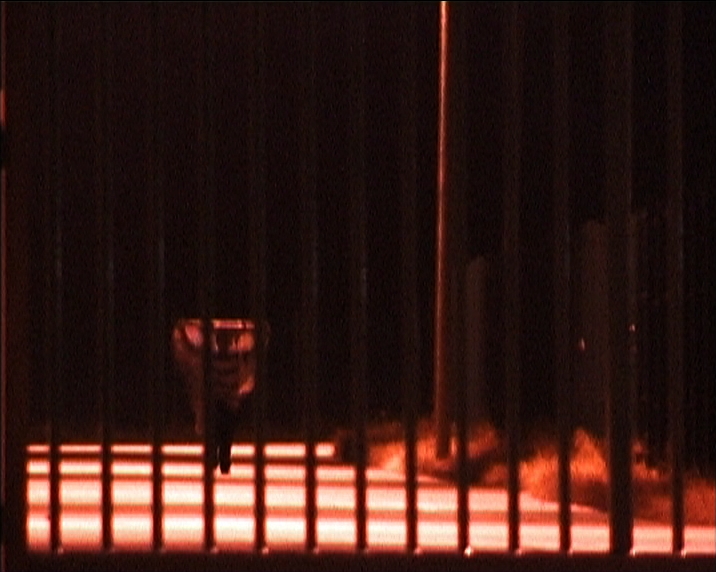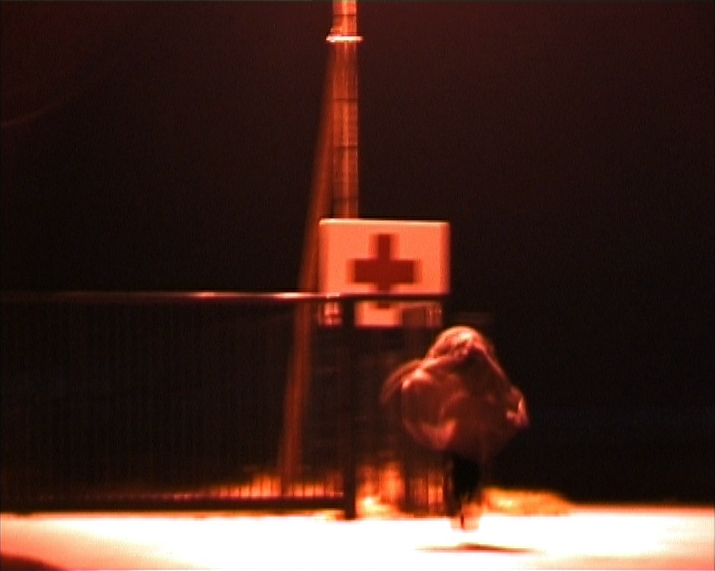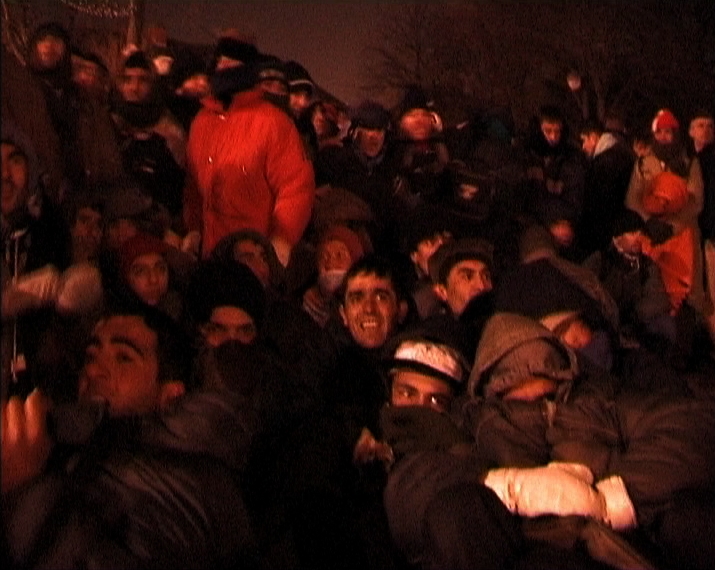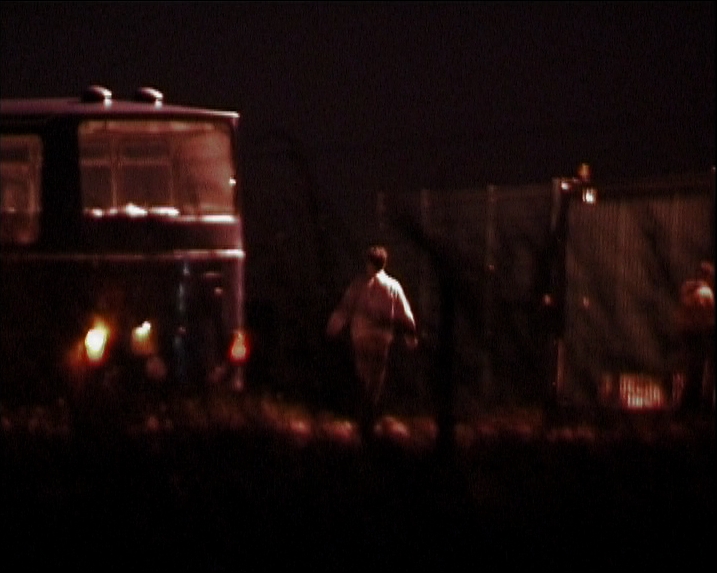
BORDER
Synopsis
In 2002, Laura Waddington spent months in the fields around Sangatte Red Cross camp, France with Afghan and Iraqi refugees, who were trying to cross the channel tunnel to England. Filmed at night with a small video camera, the figures lit only by the distant car headlights on the motorways, Border is a personal account of the refugees’ plight and the police violence that followed the camp’s closure.
Director’s statement
In the days, if you wandered along the motorways and the wastelands, you could see the refugees everywhere: waiting on the roadside or headed to the port and the freight trains. They travelled in twos or threes or sometimes in groups of twenty or thirty.
At night, I’d walk along the roads with them. It took two or three hours to reach the spots on the channel tunnel fence, where they’d start to cut the wire. Then came the arrests and the police bus back to the camp. A few hours later, they’d re-emerge and the perverse game of cat and mouse would start again.
Most of the refugees were from Iraq and Afghanistan. They’d taken six or seven months to get to France, paying traffickers to smuggle them in trucks across Iran, Turkey and the Balkans. Many had nothing left but the clothes they were standing in. In their countries, they’d been teachers, university professors, medical students, and bricklayers.
Some men died in the tunnel, others had their arms or legs cut off by the moving trains. I remember, one boy who lost his leg was out on the road, the week he was released from the hospital, trying to escape again. The months passed in limbo. I couldn’t believe we had just left them there, as if our backs were turned to them.
Laura Waddington 2002
On the making of Border
I was filming with the shutter wide open to compensate for the lack of light in the fields and this produced images, which were stuttered and blurred, and sensitive to the slightest movement of my hand. If I breathed too heavily, shivered or trembled, the blur in an image would become too great and the refugees would dissolve, like ghosts, into the reeds and bushes.
Read related passage in Scattered Truth

Press Quotes
“But the shock of the [Locarno film] festival is the cinema of Laura Waddington. Thirty-four years old, English, she lived illegally in New York, then spent a few years travelling with the world’s exiles in the most dangerous places. Due to a plane phobia, she made these journeys on buses, cargo ships, hitchhiking. But aside from planes, Laura Waddington is afraid of nothing and her video camera carries all her courage and her conscience, slung across her shoulder. Border is the trace of the months that she spent in Sangatte, hidden in the fields, each night, with Afghan and Iraqi refugees. Shot secretly, the shutter wide open, almost in slow motion, the images create an aesthetic experience of fear and of pursuit, as if emerging from a nightmare peopled with blurred figures. Border links the fields of Sangatte to that terrified part of our imagination, that lurks deep within within each one of us.”
Philippe Azoury, Libération, Paris
Read article: Caméras libres (English translation)
Read article: Caméras libres (French original)
“A thousand miles away from the television reports that vainly try to give a hypothetical identity to these displaced bodies, Laura Waddington’s desperate camera scrupulously avoids the refugees’ faces to convey an animal condition, a status of hunted beasts. Nothing predatory, no social dogma, just real empathy in this worried and audacious filming. And if the image is superb, at times pushing Border towards the boundaries of video dance and thus annoying certain guards of the temple of ethics, this is primarily due to a technical necessity, the DV camera’s shutter wide open to compensate for the lack of light, resulting in a large trembling grain, an impression of slow motion, movements like so many imprints.”
Bertrand Loutte, Les Inrockuptibles, Paris
“Subtle and powerful, the work of this English filmmaker, nomadic observer of the world and devoted translator of fear and hope, as in the film Border a tragic document about the powerless attempts of Afghan and Iraqi refugees to escape from France to England and the violent police repression that followed the closure of the camp of Sangatte.”
Elena Marcheschi, Il Manifesto, Rome
“Juxtaposed with eloquent images that suggest way more than what they actually show. The result is simply astonishing: an expressionist piece with a visual and sound design that wondrously exposes, in a reflexive manner, the pain and suffering of others as though it were your own”
Pablo Suárez, Buenos Aires Herald, Argentina
“Set only in the wide open, with refugees, silhouettes in the sheltering darkness, moving in the wind and the rain, crossing landscapes, anonymous to the eye yet known by name to the narrator, Laura Waddington … There’s a heroic compassion of quasi-Kurosawa’ian dimensions to each image, a justness to each movement that in its humbleness speaks gloriously of all the growth and learning done in all those years on the road.”
Olaf Möller, 41a Mostra Internazionale del Nuovo Cinema Pesaro Catalogue, Italy
Read catalogue essay: The Days and Years of My Travels (English original)
Read catalogue essay: The Days and Years of My Travels (Italian translation)
“Border bears witness to the harsh reality of shadows, to a group of invisible people at the side of the road and is the most eloquent political and artistic metaphor ever expressed”
Mar del Plata International Film Festival Catalogue, Argentina
“Have the fireflies disappeared? Of course not. Some of them are very near to us — they brush against us in the night; others have gone elsewhere, beyond the horizon, trying to reform their community, their minority, their shared desire. Even here, Waddington’s images remain, as well as the names—in the closing credits—of all those people she met. We can watch the film again, we can show it, and circulate glimpses, which will spark others: firefly-images.”
Georges Didi-Huberman, Survivance des lucioles, Éditions de Minuit, Paris
Read book excerpt: Survivance des lucioles (English translation)
Read book excerpt: Survivance des lucioles (French original)
“A radical call for heterogeneity, diversity, the image saturated to the limits of the visible, producing the disconcerting revelation: there is nothing left to see, only pieces to gather. It is, without doubt, what we call a vision of the world, the least obvious but the most painfully contemporary”
Bouchra Khalili, The 51st International Short Film Festival Oberhausen Catalogue, Germany
Read catalogue essay: The Pain of Seeing (English translation)
“There are few things as important in cinema today as the efforts of brave filmmakers like Laura Waddington. In the spirit of Hanoun, Ivens, Adachi and others, Waddington loaned her physical presence to the cause, spending months at the Sangatte Red Cross Camp, …The rarefied ambiance of Waddington’s images is difficult to forget.”
José Sarmiento Hinojosa, Crucial 21st Century Cinema, #DirectedbyWomen
Read article: #Crucial21DbW: Border
“The images in Border … search for a new formula of community based around sharing a common space and a gaze that would take the gaze of the other into account. These, as Sergei Eisenstein would say, “inspired images of audiovisual exaltation” emerge … from a place where politics is born, even though it is not called politics and has no representatives.”
Paweł Mościcki, Widok: Teorie i Praktyki Kultury Wizualnej no. 14, Warsaw
Read article: The Image as Common Good: on Laura Waddington’s Border (English translation)
Read article: The Image as Common Good: on Laura Waddington’s Border (Polish original)
“In these prolonged shots there is the courageous will of Waddington to explore the shadowy zones of the contemporary, the territories occupied by the invisible peoples, dragging themselves into the bubble of globalization.”
Stefania Rimini, Immaginazioni: Riscritture e ibridazioni fra teatro e cinema, Bonanno Editore, Italy
Read book chapter: Frammenti di cinema resistente (Italian original)
“The immediacy of the struggle: René Vautier named this cinema of performative immediacy a cinema of social intervention, which has as its aim the success of a struggle and the concrete transformation of a situation of conflict or injustice. This in situ cinema, nowadays accomplished… by Laura Waddington when she follows the struggle of immigrants in Border or by Godard when he made Prière pour refusniks”
Nicole Brenez, Political Cinema Today – The New Exigencies: For a Republic of Images, Screening the Past
“In this case, the nocturnal darkness is simultaneously a literal darkness (one never lit by natural light, but only by the lights of the institutions charged with keeping the refugees under control) and an ethical one: these refugees are the casualties of political decisions of Western nations that were now refusing to accept the responsibility for the damage their decisions had caused.”
Scott M. MacDonald, Comprehending Cinema, Oxford University Press
Read book excerpt: Night Light—The Modern Cine-Nocturne
“There is something tragically beautiful in the images of Waddington, which call to mind the phrase that Grandieux and Brenez used for their series on filmmakers, committed to political resistance: “It may be that beauty has strengthened our resolve.”
José Sarmiento Hinojosa, Desistfilm, Lima
Read article: Panorama: Tres cortometrajes de Laura Waddington (Spanish original)
“It was in 2002: the illegality of the situation, the police lying in wait, the race through the fields, the omnipresence of the night lit only by the danger of helicopter searchlights, all that gives her film’s images their condition of invisibility, but also, more powerfully a proximity to these men, these women and these children whose features we hardly see – whose desperate clamours we hear at a moment when faced with the police– but of who the film manages to construct, admirably, like a poem, their dignity.”
Georges Didi-Huberman, Dictionnaire mondial des images, Nouveau Monde Éditions, Paris
Read book excerpt: Figurants (French original)
“This threatening darkness permeates every image in Border, and we might go so far as to say that Laura Waddington … closely follows Theodor Adorno’s 1945 theories on the darkness of art, more specifically what the German philosopher referred to as the ‘ideal of blackness’ (Ideal der Schwärze), which would become a favored attribute of openly ‘radical’ art (radikale Kunst), from Malévich’s suprematist paintings to Ad Reinhardt’s black monochromes.”
Ricardo Lessa Filho and Frederico Vieira, Logos 52, vol. 27, no. 1, Rio de Janeiro
“Remarkable also are the filmmakers today who accompany the oppressed without any political organisation to support them, in the manner of Laura Waddington or Jean-Gabriel Leynaud or Jérôme Schlomoff and François Bon, alongside the homeless.”
Nicole Brenez, Cinémas d’avant-garde, Cahiers du Cinéma/Les Petits Cahiers, Paris
Read excerpt: Anticiper ou accompagner les luttes politiques (English translation)
Read excerpt: Anticiper ou accompagner les luttes politique (French original)
“This is why Laura Waddington decides to recapture attempts at flight specifically outside the circumscribed zone of the camp, flooded by the blinding and overseeing lights of the State. It is instead the blank spots, the area just outside, that attracts her attention: the darkness, tall grass and bushes are the occasion for those fleeing to free themselves from the headlights of the Kingdom and to emerge, in Pasolini’s words, as fireflies: “It would be criminal and stupid to place fireflies beneath a projector believing to observe them better.”
Cecilia Bima, Lacune visive: Bassa definizione per un’etica della testimonianza
Read chapter: Border: luce, bagliori e soggetti politici (English translation)
“Border appears visually grainy and ambiguous, unfolding at a hauntingly decelerated and piecemeal pace as its images leave a kind of retinal residue even as they dissolve into new scenarios. This stuttering, hazy effect prevents a kind of cognitive distancing … the camera’s limits in low-light conditions expose the ethical shortcomings of normative vision”
Iggy Cortez in Night Fever: Film and Photography after Dark, Walther König, Cologne
Read book excerpt: Nabua and Other Nocturnal Peripheries
“This approach testifies to a media-ethical stance: Laura Waddington’s protagonists hide in the noise of the image. She protects them from being discovered … This runs entirely contrary to conventional TV journalism, or even to critically intended documentary films, in which faces often serve as the most important carriers of identification.”
Eva Kuhn, Images of Illegalized Immigration: Towards a Critical Iconology of Politics, Transcript Verlag, Bielefeld
Read book excerpt: Border: The Videographic Traces by Laura Waddington as a Cinematographic Memorial
“Waddington’s meeting with the migrants of the Sangatte camp and her denunciation of the inhumane situation turns into an alter-narrative that captures the dignity of men. The video’s spoken narrative carries its images, supplementing what the camera cannot or does not want to record. The complex interaction among images—at times frozen, sometimes blurred—pushes the perception of the visible towards abstraction, while the voice takes over, supplying the details.”
Marion Hohlfeldt, Interventions, vol. 2, no. 1 , New York
Read essay: Betwixt and Between: Displacement and Liminality in Laura Waddington’s Border
“Radically opposed to the language of television and refusing the informative stance of documentary, the author shares in Border her experience of video-activism, working on the frontier of images … anchor[ing] inside her memory and that of the spectators, the undefined presence of those who, without a face, without documents and in search of a future, are reclaiming their right to exist, to be recognised, and to live.”
Elena Marcheschi, Videoestetiche dell’emergenza: L’immagine della crisi nella sperimentazione audiovisiva, Edizioni Kaplan, Turin
Read book excerpt: Oltre la rappresentazione, dentro la vita in Border di Laura Waddington (English translation)
“Causing a shockwave within the audience at the time … Border revealed the pitiful truth about the police violence ensuing from the closure of the refugee camp … Georges Didi-Huberman named Waddington’s often blurred, abstracted images made with a small video camera firefly images.”
Hilde Van Gelder, Ground Sea: Photography and the Right to Be Reborn, Vol. I, Leuven University Press
“It feels increasingly important as Border’s creation retreats into the past, even as refugees continue to arrive at Europe’s borders, to consider the possibility that although the individuals it records are no longer in this place – and we have no access to what has become of them – their images retain, or regain, their resilient power and present relevance at each new viewing.”
Alison Smith, Georges Didi-Huberman and Film: The Politics of the Image, Bloomsbury Publishing, London
Read book excerpt: Anachronism, Survival and Filmic Fireflies
“Just as the Sonderkommando photographs were taken clandestinely from beneath the gaze of the SS, Waddington evaded the surveillance of the French police and helicopter patrols as she bore witness to the plight of asylum seekers trying to reach England. Border presents her stolen testimony, operating outside the familiar iconography of mainstream media’s representation of asylum seekers.”
Chari Larsson, M/C Journal, vol. 15, no. 1, Australia
Read article: Suspicious Images: Iconophobia and the Ethical Gaze
“How can we avoid the blindness that comes from both darkness and light? … one way to achieve this is to pay attention to the untapped potential of images, which can reveal the singular in unknown, surprising forms. An example is Laura Waddington’s film Border, about Afghan and Iraqi refugees trying to reach England via the English Channel … The same medium that kills the experience can resurrect it, by giving us back a sense of empathy, of communion.”
Michel Laub, Como definir uma existência naqual a luz só aparece quando se está de olhos fechados?, Valor Econônomico, São Paulo
“Sangatte, frontier of the world. And metaphor with which to speak of all the frontiers of the world, and of Europe at a time when refugees are refused and, at best, inhabitants of a camp. A red sky and black earth, sometimes a black sky and red earth. Images that tell of unreality, as in a dream, a nightmare, something that you carry inside you, an intimate space, that those around you do not suspect.”
Federica Sossi, Jura Gentium Cinema, Italy
Read article: Sangatte: Frontiera del mondo (English translation)
Read article: Sangatte: Frontiera del mondo (Italian original)
Read article: Sangatte: Frontiera del mondo (German translation)
“Brutal contrast between the speeds of displacement—migration and travel—and brutal contrast between the places—clandestine and domestic—spaces that hardly ever meet and do not form ‘contact zones’ but rather ‘Europe’s backdoor’ to use the artist’s words ‘like a mirror held up to the world, that we have chosen to turn our backs to.’”
Marion Hohlfeldt, Journal d’Exposition: Galerie Art & Essai, no. 10, Rennes
Read exhibition essay: Demain vous n’y penserez plus (French original)
“Border, on the other hand, represents the more socially engaged pole of this type of cinematic gleaning: the film is exactly like Laura herself, which in this case is a compliment. It is a curious, sincerely affected and semi-clandestinely filmed series of escape attempts by Afghan refugees … Faceless, nameless, without histories—in short, exactly as they appear in the average consciousness of the distant tragedy in the Middle East.”
Jurij Meden, Kinoplus, Ljubljana
Read article: Pesaro 2005 – skakanje na glavo (Slovenian original)
“In the dark of the night, the landscape becomes an ally of the refugees, concealing them from the police patrols. The ghostly, trespassing presence of the “imprisoned” figures, the spontaneity with which they move across the landscape, temporarily suspends the customary regime. This landscape provides a new way of seeing, a different perspective and fresh opportunity to relate to the question of migration – a chance to perceive the position of refugees within the space of Sangatte in a metaphorical sense.”
Mari Laanemets, Crime and Punishment Exhibition Catalogue, Kunsthalle Tallinn
Read article: Maantee, teeperv, buss: Laura Waddington filmist Piir (English translation)
“What Waddington was witness to, and what she tries to communicate, is the beauty and strength of a group of people motivated by hope to attempt what seems impossible. What she saw in the darkness around Sangatte was always moving and sometimes tragic, but it was also a form of spiritual light in the darkness”
Scott M. MacDonald in Technology and the Garden, Dumbarton Oaks, Washington
Read book excerpt: Gardens of the Moon; The Modern Cine Nocturne
“Each shot in Border creates a counterpoint regarding the established visual language created and dominated by culture, which is—in very simple and direct terms—the mask which hides the true face of the oppressor.”
Pedro Tavares, Politics & Poetry, European Foundation Joris Ivens website
Read interview: Sep 2016: Border (Laura Waddington) Curator: Pedro Tavares
“Intent on transgressing the modes of cinéma-verité, she does not observe the refugees from the outside: she moves with them, in the cold of the night; aligning herself with their anguish and their fears, undertaking an insecure negotiation with reality. She performs a total adhesion: seeking a visual cancellation of her own gaze, in order to become part of the fields, of the laboured breaths, of those attempts to run towards a more serene destination.”
Vincenzo Trione, Artivismo: Arte, politica, impegno, Guilio Einaudi Editore, Turin
Read book excerpt: Immaginari migranti (English translation)
Read book excerpt: Immaginari migranti (Italian original)
“Placing the moral and ethical responsibility to look, fairly on the shoulders of the spectator: it is spectatorship outside of the politicised hierarchies of the media. Border is a potent reminder of what lies beyond the boundaries of the mainstream news press, a highly efficient mechanism for showing us either nothing, or showing us only clichés.”
Chari Larsson, Reading the Suspect: Interpretations and Aesthetics Conference, University of Queensland
Read conference paper: Suspicious Images: Iconoclasm and the Prohibition of Representation
“These works elaborate calls. They address viewers who more likely belong to the richest economies in the world, inviting them to engage perceptually, sensorially, sensibly, cognitively, corporeally with the distressful conditions of migration that they are suggested to be a part of. They are a call for historicization: they situate the forced displacements as a prolongation of colonialism. …They are a call for empathy: the artists are voicing or depicting their own empathy (Waddington, Lapointe, Ai, and Iñárritu in particular).”
Christine Ross, Art for Coexistence: Unlearning the Way We See Migration, MIT Press, Cambridge, MA
Christine Ross, Art for Coexistence: Unlearning the Way We See Migration


Awards
- Grand Prix Essai / Art Vidéo, Festival Coté Court, France
- First Prize Videoex 2005 – International Experimental Film and Video Festival, Zürich, Switzerland
- Special Mention of the Ecumenical Jury, 51st International Short Film Festival Oberhausen, Germany
Selected Film Polls and Best-of Lists
- “Desistfilm’s Top 50 Films of All Time” (Choice of Nicole Brenez). Desistfilm Online Film Journal, Peru, 2012
- “Nicole Brenez’s 50 great avant-garde films/events 2000-2009.” In “Best of the Decade: Avant-Garde, 2010.” Film Comment, New York
Selected Screenings and Exhibitions
- 57th Locarno International Film Festival, Switzerland [world premiere]
- 33rd Montreal International Festival of New Cinema and New Media (FCMM), Canada
- 19th Festival International du Film de Belfort – Entrevues, France
- 34th International Film Festival Rotterdam, the Netherlands
- La Semaine des réalisateurs, FESPACO, 19th Pan-African Film & TV Festival of Ouagadougou, Burkina Faso
- One World: 7th International Human Rights Film Festival / Jeden svět, Prague, Czech Republic
- 51st International Short Film Festival Oberhausen, Germany
- The New York Video Festival, Walter Reade Theater, Film Society of Lincoln Center, New York, US
- 59th Edinburgh International Film Festival, Scotland
- European Parliament, Brussels, Belgium
- The Age of Migration, The 54th Robert Flaherty Film Seminar, Colgate University, New York, US
- Women with Vision, Walker Art Center, Minneapolis, US
- Cine y casi cine, Museo Nacional Centro de Arte Reina Sofia, Madrid, Spain
- Cinéma du Réel, 31e Festival international de films documentaires, Centre Georges Pompidou, Paris, France
- In Praise of Independents: The Flaherty, National Gallery of Art, Washington, DC, US
- La Frontera infinita, Le Jeu de Paume, Paris, France
- La Frontera nos cruzó, MUNTREF – Museo de la Universidad Nacional de Tres de Febrero, Buenos Aires, Argentina
- Vidéo et après : Laura Waddington, Musée National d’Art Moderne, Centre Georges Pompidou, Paris, France
CollectionS
- Musée National d’Art Moderne, Centre Pompidou, Paris
- Bibliothèque Nationale de France, BnF, Paris
- International Film Festival Oberhausen, Film and video archive, Germany
- Musée national de l’histoire de immigration, Paris
- Cinémathèque de Tanger, Morocco
- INVIDEO Archive A.I.A.C.E, Milan, Italy
- Bibliothèque de l’Université Laval, Quebec, Canada
- Bibliothèque de l’Ecole supérieure des Beaux-Arts, Nimes, France
- Bibliotheque de l’Universite de Geneve, Switzerland
- Texas A&M University Library, Texas, US
Back to top